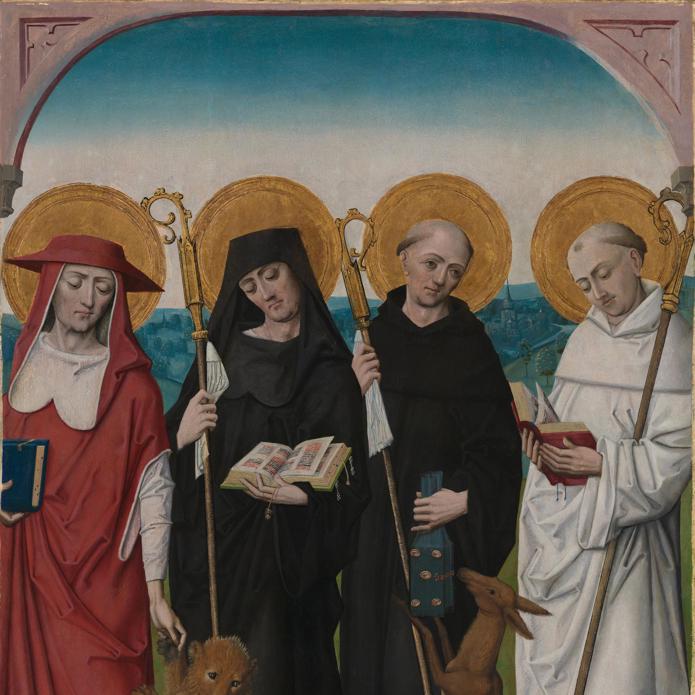Workshop of the Master of the Life of the Virgin, 'The Mass of Saint Hubert: Right Hand Shutter', probably 1485-90
About the work
Overview
This panel once decorated the inner face of the right-hand shutter of an altarpiece made for the Benedictine abbey in Werden, near Cologne. An earlier episode of the saint’s life – the moment of his conversion to Christianity – appeared on the left-hand shutter.
After his conversion, Hubert devoted himself to his faith, and this scene shows him being consecrated as Bishop of Liège. An angel appears before him with a stole (part of the liturgical dress of a bishop, worn around the neck). Behind, a deacon holds a mitre (hat) and a crosier (an ornamental crook), which were only worn by bishops.
A relief sculpture of God the Father enthroned forms the central part of the gilded altarpiece, overseeing the ceremony. He is flanked on either side by Saints Peter and Paul, significant here for their role in spreading the word of Christ as the Church’s first apostles – perhaps a reference to Hubert’s own life of preaching.
Key facts
Details
- Full title
- The Mass of Saint Hubert: Right Hand Shutter
- Artist
- Workshop of the Master of the Life of the Virgin
- Artist dates
- active second half of the 15th century
- Part of the series
- Two Shutters from the Werden Altarpiece
- Date made
- probably 1485-90
- Medium and support
- oil, originally on wood, transferred to canvas
- Dimensions
- 123.2 × 83.2 cm
- Acquisition credit
- Bought, 1854
- Inventory number
- NG253
- Location
- Not on display
- Collection
- Main Collection
Provenance
Additional information
Text extracted from the ‘Provenance’ section of the catalogue entry in Susan Foister, ‘National Gallery Catalogues: The German Paintings before 1800’, London 2024; for further information, see the full catalogue entry.
Exhibition history
-
2011Devotion by Design: Italian Altarpieces before 1500The National Gallery (London)6 July 2011 - 2 October 2011
-
2014Strange Beauty: Masters of the German RenaissanceThe National Gallery (London)19 February 2014 - 11 May 2014
Bibliography
-
1959Levey, Michael, National Gallery Catalogues: The German Schools, London 1959
-
2001
C. Baker and T. Henry, The National Gallery: Complete Illustrated Catalogue, London 2001
-
2024S. Foister, National Gallery Catalogues: The German Paintings before 1800, 2 vols, London 2024
About this record
If you know more about this painting or have spotted an error, please contact us. Please note that exhibition histories are listed from 2009 onwards. Bibliographies may not be complete; more comprehensive information is available in the National Gallery Library.
Images
About the series: Two Shutters from the Werden Altarpiece

Overview
These paintings once formed the shutters of an altarpiece made for the Benedictine abbey at Werden, near Cologne in Germany. The shutters were decorated on both sides, and could be closed to protect the central part of the altarpiece, which has not been traced.
The inner and outer faces have been separated, creating four panels out of two. The inner faces, which would have been visible when the shutters were open, show events from the life of Saint Hubert. The outer faces each show four standing saints, including Saint Hubert and Saint Benedict, as well as other members of the Benedictine Order.





